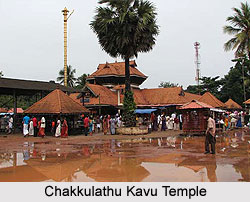 Chakkulathu Kavu Temple, dedicated to Goddess Durga is located in the border of Pathanamthitta District and Alappuzha District. It is 12 Km westward from the town of Thiruvalla in Neerattupuram Junction. The famous rivers of Pampa and Manimala flow on either side of the temple. Pongla is the major festival that is celebrated here with much pomp and enthusiasm. The festival is mainly attended by women who offer various items to the deity. This centuries old temple has a very interesting legend associated with it. The history of the temple is also associated with this legend.
Chakkulathu Kavu Temple, dedicated to Goddess Durga is located in the border of Pathanamthitta District and Alappuzha District. It is 12 Km westward from the town of Thiruvalla in Neerattupuram Junction. The famous rivers of Pampa and Manimala flow on either side of the temple. Pongla is the major festival that is celebrated here with much pomp and enthusiasm. The festival is mainly attended by women who offer various items to the deity. This centuries old temple has a very interesting legend associated with it. The history of the temple is also associated with this legend.
The legend of the temple has some divine connections with the story of Sumbha and Nishumbha referred to in the Devi Mahatmyam. According to the story, once there were two demoniac characters called Sumbha and Nishumbha. They through their rigorous meditation had pleased Lord Brahma and derived super human powers. They received a boon that they could be killed only through a battle with woman. Upon receiving the powers the demons began tormenting the common masses. They also conquered Lord Indra and other Devas of heaven. They conquered their thrones and began ruling over them. The common people feared them. The helpless Devas had to flee away and take shelter in remote jungles.
Saint Narada felt pity at the misery of the Gods. He approached his father Lord Brahma and narrated the complete state of affairs. Brahma reminded Narada that ups and downs are the law of life and that was what the Gods were experiencing. He told him that the demons have been granted the boon that they can be killed only by a woman. Hence, the only way out for this despicable situation is that Goddess Durga can kill them. The Devas accordingly moved in search of Goddess. Reaching near the Himalaya the epic King of the mountains, they started chanting powerful mantras in tribute of the Goddess who in herself was power, knowledge, creativity, benevolence and blessings. They continued chanting her name to appease her. Goddess Parvati had just arrived on the banks of river Ganga and heard the echoes of the mantras. There was a touch of grief and pleading in the sounds of Devas. Goddess Parvati grasped the pitiable plight of Devas. There emerged another Goddess from within her. This was the incarnation of Goddess Durga, who had taken this form to rescue the Devas from the troubles caused by the asuras. The story culminates in a terrible fight between the Goddess and Asuras under the leadership of Sumba and Nishumbha. Teh battle took a terrible form and finally at the end all the asuras were annihilated by the Goddess. The Devas got back the early powers and prosperity and throne. Sage Narada then appeared in front of them and narrated about the invincibility of goddess Durga. She is thus the cause for the creation, maintenance and destruction the universe.
It is believed that the Goddess residing in Chakkulathukavu is another form of this all pervading Goddess Durga.











